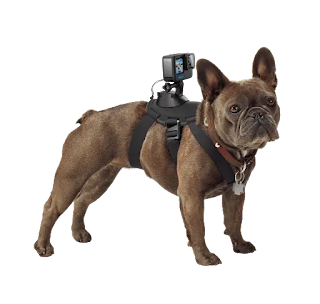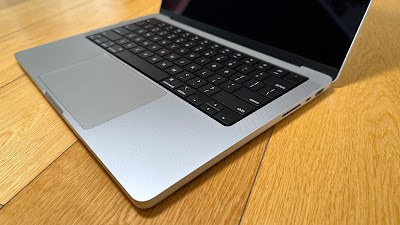Although I've reviewed hundreds of gadgets over the years, every now and then something turns up on my doorstep that takes me by surprise. You'd think after all the phones, laptops and accessories, the neverending stream of earbuds, even electric bikes and actual cars, there'd be nothing I couldn't handle.
But that's technology for you, there's always something new just around the corner.
While I consider myself to be a creative person, I'm certainly woefully underskilled when it comes to some of the creator-focused tools available out there. In fact, the more I discover how people are using tech to make art and design, the more I realise what a know-nothing-bozo I really am.
And the new device from Wacom makes me feel like a total amateur.
The Wacom Cintiq Pro 27 pen display is a big unit - obviously, at 27-inches, the LCD panel itself is large enough, but there's literally a lot under the hood here; plenty of processing and fan technology adding up to quite a solid body behind the screen, all weighing in at 7.2 kilos - and that's before you add the stand.
The Cintiq Pro 27 can't stand up by itself, so you have the choice of using your own 3rd-party VESA 100-compatible arm or mount, or Wacom's own, ingeniously designed desktop stand. This latter option is also very large and heavy - but it needs to be, not just to support the display but to allow you to move it into your preferred position without slipping around on your desktop. This it does brilliantly - although you can't fully rotate the screen from landscape around into portrait, you can easily swivel it off the horizontal but more importantly, you can adjust the viewing angle from almost vertical to completely flat - ideal when working while standing, perhaps in a drafting or collaboration environment.
But back to the main event, the Cintiq Pro 27; as Wacom's first 120Hz, 4K pen display it functions extremely well just as a monitor. The 10-bit colour, 99% RGB screen has been Pantone Validated, which means the colours are about as true-to-life as you can get. The extra size is fantastic for productivity, allowing you to have multiple, large windows open simultaneously and the high refresh rate means video and gaming is super smooth. In short, everything looks great.
Initial setup is pretty much just plug and play - with a full range of connectivity options, from simple USB-C to USB-C, to DisplayPort and HDMI or even a combination. All the required cables are included.
Once plugged in, you'll need to download the Wacom Center desktop app from which you can install the required drivers, update the device and get to work finding your way through the many, many menus of settings and customisations. For this is really what puts the Wacom pen display in a whole other league.
To begin with, there are the usual settings pertaining to the way the screen looks - brightness, contrast, that sort of thing. These settings themselves are accessible using the shortcut keys positioned behind each side of the screen - a bit like gaming controllers. These buttons can be assigned pretty much any shortcut or function you like - and they can be different shortcuts and functions for different apps. What's more, the buttons can also be used to launch radial or grid displays of on-screen shortcuts. Those shortcuts can then open more grids of shortcuts - shortcuts within shortcuts if you like. All of this is an effort to streamline your workflow - rather than pointing and clicking with a mouse - or even worse, endlessly typing on a keyboard, with a few well-programmed shortcuts you should be able to access any favourite functions in a split second.
The same basically applies to the Pro Pen 3, which is included, along with a detachable pen holder which can be quickly screwed into any of the multiple accessory mounts around the edge of the display.
Wacom describes the Pro Pen 3 as "36 pens in one." This is because you can adjust the weight, thickness and button configuration to your exact preference, using your favourite combination of available accessories. The result is quite astounding; with 8,192 levels of pressure sensitivity and the ability to recognise what angle you're holding the pen at, it's easily the most natural and responsive digital stylus I've ever used. Whether you're using it as a paintbrush, a pencil or a pastel, the result is so realistic I quickly found myself forgetting it wasn't the real implement drawing on paper.
Best of all; no charging. No battery. Wacom's ingenious electromagnetic tech means everything works just by being in close proximity to the screen - even the three buttons are fully programmable. (Not to mention removable!)
The combination of such a customisable writing implement and easily accessible, physical shortcut buttons means your workflow is totally uninterrupted - whether you're manipulating 3D objects, animating or adding special effects, creating unique artworks or perhaps adding the finishing touches to some corporate design, with the right software and quick access to the settings you need, mouse and keyboard can be left aside n favour of a more tactile, hands-on experience.
An impressive suite of trial software offers is also included so even if you're already familiar with your favourite graphic creation tools, it might be worth giving a few new ones a go to see if they have anything else to offer.
Although using an enterprise business tool like the Cintiq Pro 27 is a long way above my usual skillset, because it's so infinitely customisable, I found it didn't actually take me too long to become reasonably proficient at a range of basic tasks. Intriguingly, every time I used it, I thought of more ways I could use it - it's been an amazing catalyst for my creativity. Suddenly I'm doing even mundane jobs - like rudimentary video editing - in a whole new way.
And I'm sure I've hardly scratched the surface of what this technological behemoth is truly capable of. Hopefully, I've been able to give you a little taste of what's possible though - there's a reason why creatives at the top of their game (think certain movie special effects studios in Wellywood, for example) are using Wacom's pen displays to work their magic.
Click here for more information and pricing on the Wacom Cintiq Pro 27.















.JPG)
.JPG)
.JPG)
.JPG)
.JPG)
.JPG)
-5.jpg)
-8.jpg)
-4.jpg)
-7.jpg)
















-7.jpg)
-12.jpg)
-13.jpg)
-8.jpg)
-10.jpg)
-14.jpg)